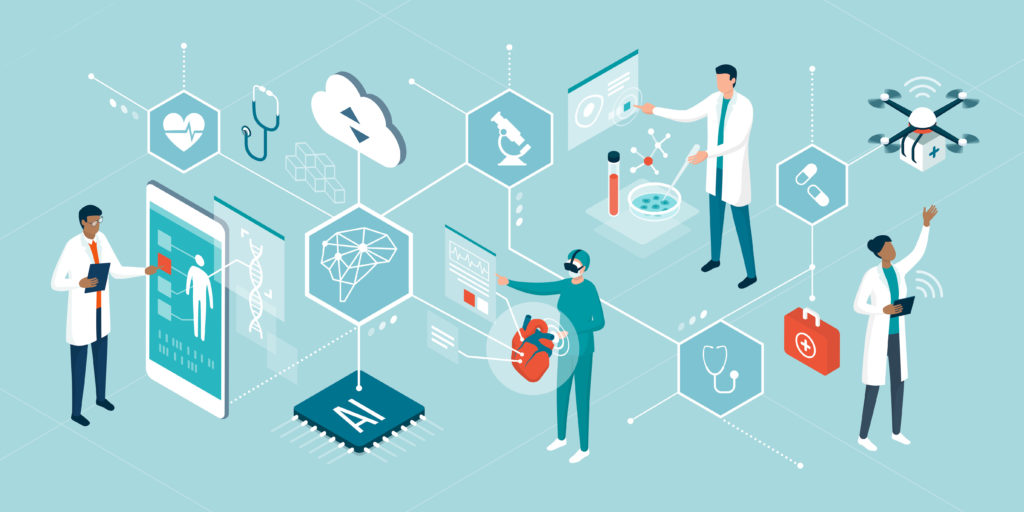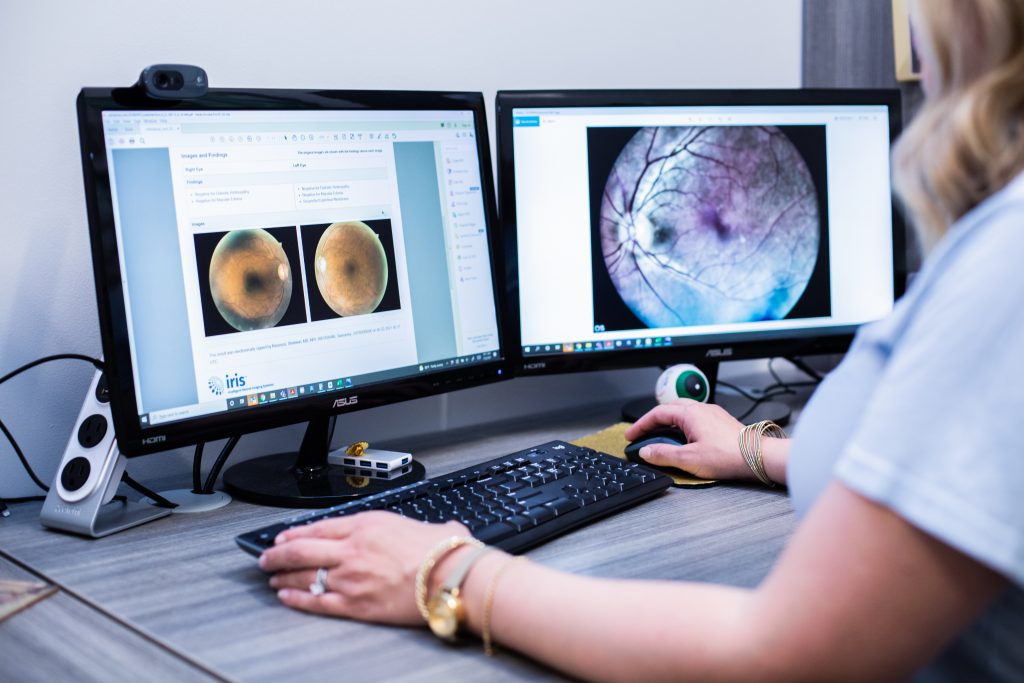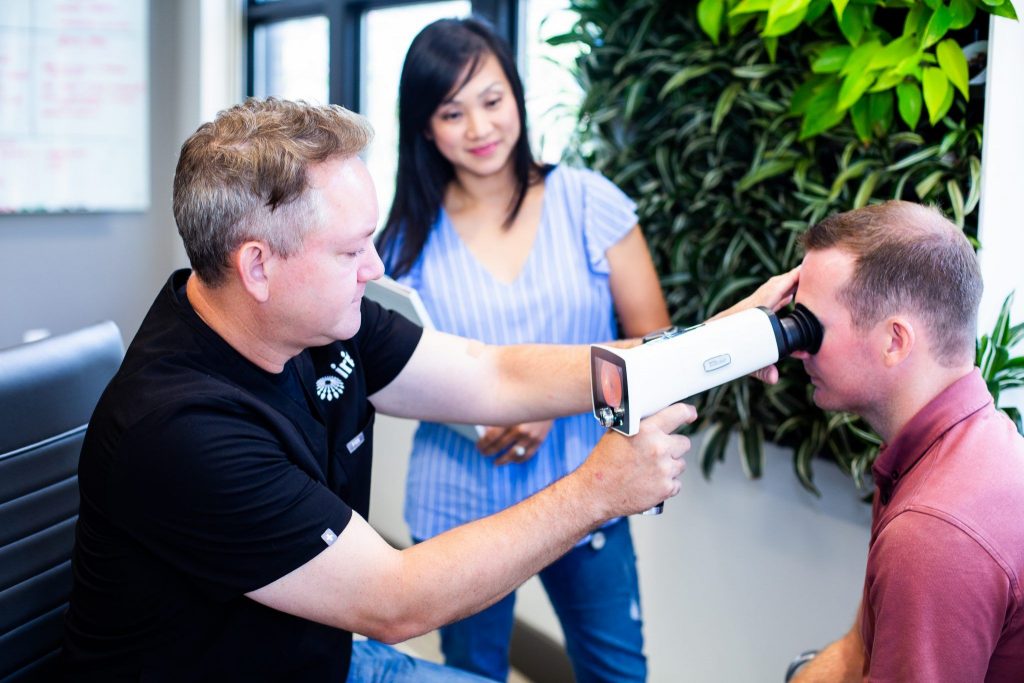The Future of Healthcare: How Technology Can Help End Preventable Blindness

Introduction
Technological developments are transforming the face and function of almost every industry, and healthcare is no different. Digital health technology solutions are sprouting up from the ground upon which we stand, using innovative ideas to power quicker and better diagnoses for more effective treatment plans.
Painting the picture of the future of healthcare means changing colors and direction constantly to keep up with the speed of development of new health technologies. Specifically, in the field of vision and ophthalmology, there have been incredible developments in equipment, testing, and imagery that could make the end of preventable blindness a reality for many. But one thing is for sure: across any area of medicine, the future of healthcare is going digital.
In this blog, we will take a look at the future of healthcare technology as it pertains to the future of healthcare both at large and specifically within the field of ophthalmology and eye care. From artificial intelligence that helps catch diseases earlier to the end of paper record-keeping, health technology is paving the way to a better medical industry.
TABLE OF CONTENTS
- Introduction
- The Future of Healthcare
- Diabetic Retinopathy AI
- EMR Systems
- Easier-to-Use Testing Equipment
- Efficient Examinations
- Ending Preventable Blindness with IRIS Technology
- Why IRIS?
- What’s Next?
The Future of Healthcare
With the advent of emerging technologies and advancements in the medical field comes better chances to detect, treat, and even prevent disease in some cases. In the history of medicine, this has taken the form of vaccines that have eradicated certain diseases that used to cripple populations, and therapies that ease symptoms of illnesses such as autoimmune disorders.
Currently, in eye care, we have seen this most prominently with same-day diabetic retinopathy diagnoses and preventative care aimed towards eliminating preventable blindness. Let’s jump into the healthcare technology that has made this part of the future of healthcare possible.
Cloud Computing in Healthcare
Almost as big of a tech buzzword as “artificial intelligence”, cloud computing is changing the future of healthcare as we know it to be.
A simple definition of cloud computing is the ability to generate, consume, and store data digitally instead of physically. Healthcare is taking full advantage of this new capability, as the usage of such technology has multiple positive outcomes for healthcare practices.
Cloud computing benefits practices just as much as their patients. Firstly, cloud computing lowers costs for healthcare organizations, as you only pay for the storage that you end up using. Not only that, but patient data, like a fitness tracker and heart rate monitor information, can be automatically tracked and uploaded to cloud storage to contribute to better treatment plans and health profiles.
A huge benefit of cloud technology to specifically patients would be knowing that their private medical information is safe and secure. Cloud technology not vastly improves intercommunication between medical offices by allowing files and information to be easily shared, but it also encrypts and protects these files so that they stay safe.
As safe as these files are thanks to cloud technology, patients are able to access their medical records even more easily because of these systems. With a username and a password, patients can create an account and use it to send their providers messages, schedule appointments, and see test results. Overall, cloud technology helps patients stay up-to-date with their medical appointments and allows them more access to their own health documents and test results, which means patients feel like they have more control over and access to their own health.
EMR Systems
Electronic medical record systems have been around a bit longer than other types of technology that are breaching the medical industry, but they have revolutionized medical offices all the same. EMRs are essentially the digital version of the paper chart that is traditionally kept in a clinician’s office. They make it easy to add medical information to a patient’s chart, as well as edit existing information.

Furthermore, EMR systems allow clinics to save physical space in their office and optimize workflow by easily keeping track of the patients visiting a practice. EMR systems make it easier to contact labs, pharmacies, hospitals, in order to get lab results faster, order prescriptions quicker, and refer patients instantly.
Before, with paper records, practices risked losing them in a fire, misplacing them, or having hard-to-read or outdated information. Now with digital copies of everything, these issues are obsolete. EMR systems paint a bright picture of the future of healthcare, increasing office organization, efficiency, and patient support while reducing errors in documentation.
Easy-to-Use Testing Equipment
Advances in testing equipment are helping to define the future of health technology as well. New and improved ocular testing equipment is allowing healthcare providers to perform tests that previously only specialized eye care professionals could perform.
Particularly, there are fundus cameras on the market that are easy to use in a variety of settings, meaning eyesight-saving tests can be performed during a patient’s annual check-up, during a home health visit, or even a trip to the pharmacy. These cameras are handheld, and thus portable and better for offices with less space.
Tabletop cameras are a more expensive option, but they take a higher-quality image and require less training to operate—and the better the image, the better the opportunity is to diagnose pathology.
The other ocular equipment option in modern-day healthcare technology is the handheld fundus camera. Handhelds are easier to use in locations that require technology to be portable and are a more affordable option compared to tabletop cameras. The images produced by handheld devices are still of great quality, but because of their motility, there is a chance of capturing images of a slightly lesser quality than would the tabletop cameras.
The ability of healthcare providers to utilize teleretinal imaging equipment for preventative care creates more affordable and accessible early detection procedures. And early detection means better outcomes for patients with diseases such as diabetic retinopathy. It is left to the practices to decide which healthcare technologies they want to use to best assist their patients and aid their practice.

Efficient Retinal Examinations
Going hand-in-hand with enhanced medical equipment, new exam practices are making it easier for patients to actually schedule and attend preventative appointments. In times past, when patients would get referred to specialists after seeing their primary providers during their annual check-ups, the chances of them scheduling an appointment and getting those additional tests were low due to a variety of factors, including time, cost, etc.
With modern healthcare technology, patients don’t always have to go to a specialized physician for a specific type of screening. With portable testing equipment and cloud technology, any healthcare location can perform tests during an annual exam and get test results over the cloud thanks to telemedicine. For example, primary care physicians can now perform diabetic retinopathy exams in their offices thanks to advances in ocular testing equipment. The IRIS solution then enhances the images and sends them straight to professionals for evaluation, expediting a process that used to partially fall on the responsibility of patients.
Since certain important preventative tests can now be performed in nearly any location, the rates of patients getting preventative testing are going up. The future of healthcare is bright, promising quicker and more comprehensive appointments, with more patients getting the preventative tests they need.
Ending Preventable Blindness with IRIS Technology
As we’ve proven, the future of healthcare is rife with new technological solutions that indicate a better tomorrow for all patients, especially those in underserved populations. One of the healthcare technologies that is making this future possible is IRIS. IRIS, or Intelligent Retinal Imaging Systems, helps eliminate preventable blindness by bringing retinal imaging equipment to health care providers.
The health technology we’ve created at IRIS bridges the gap between healthcare organizations and specialty eye care by using cloud-based technology. Through the power of the cloud and our proprietary retinal imaging technology, IRIS makes it possible for interpreting providers to seamlessly access the retinal images taken by a healthcare organization in order to diagnose sight-threatening pathologies. Here’s an exact overview of how our healthcare technology works:
Capture
- From start to finish, the IRIS solution can be up-and-running in any health care facility in the US within 90 days. The IRIS solution uses a non-mydriatic (no dilation required), easy-to-use camera that integrates straight to an organization’s EMR.
- After choosing a camera and getting it set up, orders from a practice’s EMR tell providers how to use their cameras to capture retinal images. Our integration team helps install software and education specialists train your employees to use the simple retinal cameras either in person or virtually.
Upload
- After images are captured, they are uploaded and flow automatically and securely to our IRIS Reading Center (IRC) for diagnosis. They reside safely in our FDA-cleared cloud platform while they wait for interpretation.
Enhance
- After the image is uploaded, our proprietary image enhancement technology is automatically applied to all fundus images
- More specifically, a proprietary algorithm is applied to each photo in order to enhance the dark spots on normal fundus images that can make it hard to identify areas where diabetic retinopathy may be present.
Diagnose
- Once the image has been enhanced, an IRIS Reading Center (IRC) physician reads both the original and the enhanced photos to quickly and accurately diagnose diabetic retinopathy.
Result
- Finally, IRIS delivers the diagnoses directly back to the ordering physician’s EMR system. From there, patients are directed to appropriate specialists for treatment, if necessary.
The Future of Your Healthcare Technology: Why Choose to Partner with IRIS?
IRIS is a healthcare technology that is defining the future of retinal care, and the reasons are cut-and-dry: the benefits for both patients and doctors are undeniable.
Take Control of Your Practice’s Compliance.
IRIS enables providers who are not eye specialists the ability to administer screenings themselves. This allows practices the autonomy to be 100% compliant with HEDIS regulations if they want to be. IRIS streamlines the process of getting a diagnosis of diabetic retinopathy while minimizing errors and miscommunications.
Give Your Patients Access to Quality Testing
Studies show that 1 in 10 diabetic patients who receive an IRIS teleretinal screening will have a sight-threatening pathology. With the early detection benefit of using IRIS’s technology, practices can reduce the risk of sight loss in their patients by 90%, which helps reduce cases of preventable blindness overall.
Receive More Accurate Diagnoses
IRIS’s technology is best-in-class, averaging a 92-95% gradability rating (read more about gradability ratings here).
Save Eyesight and get a positive ROI with IRIS Retinal Exams
We benefit patients as much as we benefit the practices that implement our technology. The IRIS return on investment calculator generates an estimated financial and clinical return based on the numbers inputted to show just how much money, and sight your practice could be saving by implementing our teleretinal solution. Practices also save money with IRIS because IRIS helps practices achieve and maintain compliance with HEDIS regulations.
If you want more in-depth details about the resources needed to implement a tool like IRIS, connect with us to learn more.
What’s Next?
The future of healthcare technology is swiftly changing, and much of that change is benefitting those suffering from disease and illnesses. Now more than ever, healthcare technology exists that is allowing more practices to offer more comprehensive healthcare to their patients. It’s just up to them to rise to the occasion and seize the future of healthcare.
Our goal at IRIS is to eradicate blindness caused by diabetic retinopathy, and because IRIS is the teleretinal screening solution designed for the future, we know we can do it. Thus far, IRIS has helped save the sight of over 110,000 individuals and has been implemented in over 500 organizations. Our average image gradability is between 92- 95%, and practices with the IRIS solution implemented to see a fourfold increase in their patient care because of their ability to provide testing for diabetic retinopathy.
Do you want to get involved in the fight against preventable blindness? Contact us about our technology and how IRIS can help save the sight of your patients. If you want to learn more about diseases that affect sight, the state of retinal care today, or browse any case studies from our past clients, head over to our resource center.
SM 111 Rev A
Get started with IRIS today.
Want to know if IRIS is right for you? Schedule a one-on-one consultation with our team. We’re here to help.